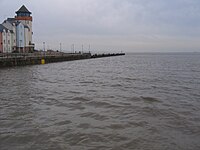Tidal resonance


In oceanography, a tidal resonance occurs when the tide excites one of the resonant modes of the ocean .[1] The effect is most striking when a continental shelf is about a quarter wavelength wide. Then an incident tidal wave can be reinforced by reflections between the coast and the shelf edge, the result producing a much higher tidal range at the coast.
Famous examples of this effect are found in the Bay of Fundy, where the world's highest tides are reportedly found, and in the Bristol Channel. Large tides due to resonances are also found on the Patagonian Shelf [2] and on the N.W. Australian continental shelf.
The speed of long waves in the ocean is given, to a good approximation, by , where g is the acceleration of gravity and h is the depth of the ocean [3] [4] .[5] For a typical continental shelf with a depth of 100 m, the speed is approximately 30 m/s. So if the tidal period is 12 hours, a quarter wavelength shelf will have a width of about 300 km.
With a narrower shelf, there is still a resonance but it has less effect at tidal frequencies. However the effect is still enough to partly explain why tides along a coast lying behind a continental shelf are often higher than at offshore islands in the deep ocean. The strong tidal currents associated with resonances also mean that the resonant regions are the areas where most tidal energy is dissipated.
In the deep ocean, where the depth is typically 4000 m, the speed of long waves increases to approximately 200 m/s. The difference in speed, when compared to the shelf, is responsible for the reflections at the continental shelf edge. Away from resonance this can stop tidal energy moving onto the shelf. However near a resonant frequency the phase relationships between the wave on the shelf and in the deep ocean can have the effect of drawing energy onto the shelf.
The increased speed of long waves in the deep ocean means that the tidal wavelength there is of order 10,000 km. As the ocean basins have a similar size, they also have the potential of being resonant [6] .[7] In practice deep ocean resonances are difficult to observe, probably because the deep ocean loses tidal energy too rapidly to the resonant shelves.
Tidal locking
The above concept of tidal resonance differs from another sort of resonance resulting from tides, called tidal locking, which causes a moon's rotational period to coincide with the period of its revolution around the planet that it orbits, so that one side of the moon always faces the planet.
See also
- Seiche
- Severn Barrage (proposed for the Bristol Channel).
- Standing wave
- Cavity resonator
References
- ^ Platzman, G.W. (1991), "Tidal Evidence for Ocean Normal Modes", in Parker, B.P. (ed.), Tidal Hydrodynamics, New York: John Wiley & Sons, p. 883
- ^ Webb, D.J. (1976). "A Model of Continental-shelf Resonances". Deep-Sea Research. 25: 1–15.
- ^ Segar, D.A. (2007). Introduction to Ocean Science. New York: W.W. Norton. pp. 581+.
- ^ Knauss, J.A. (1997). Introduction to Physical Oceanography. Long Grove, USA: Waveland Press. p. 309.
- ^ Defant, A. (1961). Introduction to Physical Oceanography, Vol. II. Oxford: Pergamon Press. p. 598.
- ^
Platzman, G.W. (1981). "Normal Modes of the World ocean. Part II: Description of Modes in the Period Range 8 to 80 Hours". Journal of Physical Oceanography. 11 (5): 579–603. Bibcode:1981JPO....11..579P. doi:10.1175/1520-0485(1981)011<0579:NMOTWO>2.0.CO;2.
{{cite journal}}: Unknown parameter|coauthors=ignored (|author=suggested) (help) - ^ Webb, D.J. (1973). "Tidal Resonance in the Coral Sea". Nature. 243 (5409): 511. Bibcode:1973Natur.243..511W. doi:10.1038/243511a0.



